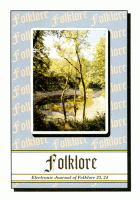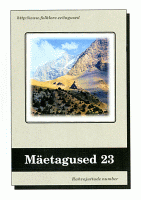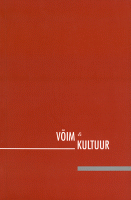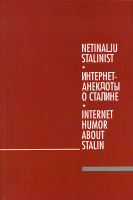Introduction
CCHFE was established in 2001 with an objective to develop a research centre that would manage to safeguard the continuity and transmission of research in the humanities that is essential for the existence of national identity and the preservation of social memory, for intellectual freedom and the full development of culture. The means proposed to carry out this goal are:
- To devise a strategy for the preservation and utilization of the communicative artefacts of the national cultural heritage.
- The advancement of the information society in the humanities, according to the needs in science and in the society.
- An escalating activism in integrating the seminal scientists of the neighbouring countries (Latvia, Russia, Finland) into the research of contact and overlapping (both in periods and common features) in our cultural space.
- The promotion of mental culture in the formation of scientific ethics and value criteria of the society.
- The development of a multilingual multimedia centre of the humanities.
The home institution of CCHFE is the Estonian Literary Museum, but its partnership programme involves seminal scholars in the humanities from the University of Tartu, from the Under and Tuglas Centre of Literature (UTCL) of the Estonian Academy of Sciences, from the Estonian Academy of Music, and from the Viljandi Cultural Academy. The centre includes about 40 individuals, half of them with a PhD and one fourth students in a doctoral programme, mainly at the University of Tartu (ELM is not an educational institution and therefore does not provide graduate studies).
The work carried out is connected with 6 research themes with goal-oriented financing by the Council of Scientific Competence, and with 15 grant projects of the Estonian Science Foundation. In the period of 2001-2004 CCHFE has been granted financial support by the state-financed programmes "Estonian language and national culture", "Estonian language and national memory", and "Scientific collections in the humanities and in the natural sciences".
Estonian Literary Museum is not only a research institution but a conglomerate of a research institution and several national archives. Research work is greatly enhanced by the fact that three fundamental archival units are situated under the same roof. Those are:
The Archive Library which collection include more than 808,400 registered units (by Dec 31, 2003) that is an archival library of great scholarly value, where the older printed matter published in Estonia and Livonia both in Estonian and German is represented nearly exhaustively;
Archives of Estonian Cultural History which include more than 300,000 archival units, among them collections of manuscripts, art, photos, tapes and films;
Estonian Folklore Archives, which include more than 5000 archival units of manuscripts, collections of photos, sound recordings and video recordings of nearly 20,000 archival units.
There are facilities for arranging conferences, working meetings, exhibits, and other academic or cultural events. Research themes are guaranteed by experienced assistant personnel. There are three net servers operating in the building (Haldjas, Ohto and Kirmus), whereas the existing computer equipment is impressive in size and in good order.
The research work carried out in ELM was evaluated, and credited with "excellent" by an international committee called by the Estonian Higher Education Accredit Centre.
ELM is a member of the International Council of Literary Museums (ICLM) that unites literary museums of the world, and functioning as the coordinator of research between literary museums in the 6-member council of the committee that unites 358 members.
One of the leaders in Estonia of the UNESCO programme "Memory of the World" is the Archival Library of the Literary Museum. The folklorists of the Literary Museum are active participants in the international network of folkloristics: The Folklore Fellows, International Network of Folklorists and the International Society for Folk Narrative Research (ISFNR). Folklorists of ELM carry a leading role in the activities of the Baltic Institute of Folklore. The ethnomusicologists of ELM are members of the International Council of Traditional Music and in the European Seminar of Ethnomusicology. The scholars included in the top centre of ELM participate also in the International Committee of Finno-Ugristics, in the International Organization of Folklore Festivals and Folk Art (CIOFF), in the European Folklore Institute, in the International Society of Semiotics, and in other international scholarly societies.
The most significant research results of the Estonian Literary Museum have evolved from the specific nature of the institution as a combination of archives and research units. The leading trends in the activities of ELM in the last decade, which likewise define the premise and orientation of the activities of CCHFE, are the following:
- Intensive activities in the field of digital media and data base: the publication of e-journals in folkloristics, and the digital publication of research works; the creation of database in folklore, folk music and literary history, the publication of e-anthologies of folklore, the ERNI project of literary history; data bases ELLEN, KLAABU, HERBA, etc.
- The publication of text critical editions of source material that is fundamental in Estonian national culture: the correspondence of O. W. Masing, the dictionary of S. H. Vestring, the collected works of F. R. Faehlmann, etc.
- The continued publication of academic folklore editions in the series "Monumenta Estoniae Antiquae": proverbs and riddles, runic songs (regilaul), legends.
- Active research carried out in the folklore, traditional music, folk beliefs and ethnology of Estonians and other peoples.
- The restoration of the European context of Estonian culture: the assembling of the archives of Exile Estonians at the Archives of Cultural History, the publication of the more significant correspondence (e.g. I. Ivask - A. Oras) and other non-fictional source material (diary of K. Ristikivi) in commentated editions.
- The research of literary institutions and organizations with applying the so-called thick description methodology.
- The collecting, research and publication of the non-fictional memory data of the people.
The most urgent immediate tasks of CCHFE starting from 2004 are:
- The further enlargement and condensing of international cooperation, mainly: the compiling and editing of the bibliography "Internationale Volkskundliche Bibliographie - International Folklore Bibliography - Bibliographie Internationale d'Ethnologie" (SIEF) that has been the task of the Literary Museum since (editor-in-chief K.-M. Rooleid); the creation of a cooperation network of researchers of the cultural ideology and functional mechanisms of the Soviet period (partner institutions: A. Ahmetova Research Centre in St Petersburg, Lev Tolstoi Memorial Complex in Yasnaya Polyana, H. Heine Institut in Düsseldorf, Balzac Research Centre in Paris, etc.); the arrangement of the international Siberia-focused conference of anthropology "Generation P" on Oct 8-10, 2004 (partner: Max Planck Institute of Social Anthropology); development of the project "Music, National Identity, Ethnicity and Cultural Diversity in Europe" (partner: Tampere University) together with Lithuanian Academy of Music and Latvian Academy of Music; the final stage of the Balto-Finnic proverb project "Proverbia septentrionalia" in cooperation of the Finnish Literature Society and Joensuu University.
- The further intensified activities in digitalizing cultural heritage and joining of corresponding international projects: mainly, to create an environment that would make the collections of cultural heritage in the humanities available to the international research community, in accordance with the principles drawn in the eEurope 2002 Action Plan (2002) of the European Union; to provide necessary technical equipment for the digitalisation, collection, preservation, and utilization of archival collections; participation in the development of standards and norms for the presentation of digital information, in its contextual research and application of the meta data system. At the same time it is necessary to monitor that the accentuation and the availability level of the background investigation correspond to the needs and requirements of the Estonian educational system. It is absolutely necessary that the cooperation mega project with the Finnish Literature Society to digitalize the runosongs and regilaul will continue in the future.
The work groups and partner members of CCHFE have been leader actors in various scholarly events organized in Estonia during the period of 2001-2004. The major ones were:
- an international conference to honour Oskar Loorits "Popular Religion and Folklore at the Turn of Millennium: Contemporary Research Methods" on 9-12 November, 2000 in Tartu;
- an international symposium "Sturm und Drang in Livonia. Patterns of riot - Der Sturm und Drang in Livland: Rebellionsmuster im Leben und in der Dichtung. J. M. R. Lenz 250 - K. J. Peterson 200" on 7- 9 September, 2001in Tartu;
- "Sacred and Profane in the Dialogue of Cultures: Ritual and Generic Aspects" on 18-19 April, 2002 in Tartu;
- Pan-European conference "Cultural Context from the Archaeoastronomical Data and the Echoes of Cosmic Catastrophic Events" on 27-30 August, 2002 in Tartu, Viluste and Tõravere;
- "Eros and Language: The Rhetorical Patterns of Translatability and Understanding" on 31 May till 2 June, 2002 in Käsmu;
- an international seminar "Popular Religion in Multiethnic and Multiconfessional Environment" on 6-7 December, 2002 in Tartu;
- the second international symposium of Baltic German literary culture "Hier ist woanders: Das baltische Welterlebnis der Keyserlings" on 18-21 September 2003 in Tallinn and Tartu.
The role in arranging international scholarly events has been remarkably active on part of the ELM Folklore Department and J. and R. Undusk from a partner institution (UTCL).
Since 1996 are published two peer reviewed e-journals in folkloristics: "Folklore: Electronic Journal of Folklore" (http://www.folklore.ee/folklore) in English and "Mäetagused" (http://wwww.folklore.ee/tagused) in Estonian. Articles in these journals are provided by international authors, the organizational and financial coverage and editorial work is provided mainly by the Folklore Department of ELM.
In addition to the activities on the level of working groups, an attempt of humanitarian integration centred around one wider research team is also planned. The theme selected is the relationship of culture with society, power and state, particularly the functioning of culture under the conditions of a totalitarian regime. There have been several conferences and seminars focusing on these topics, the main results since 2003 have been published in a series of so-called red annuals: "Power and Culture" (2003), "Internet Humour about Stalin" (2004), "Conforming Texts" (forthcoming in 2005).
 Eesti keeles
Eesti keeles


